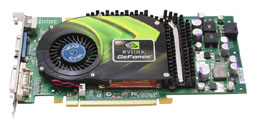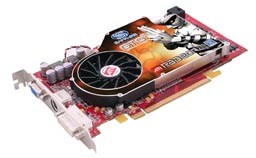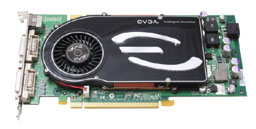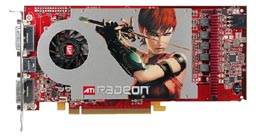Mid-Range to High-End Buyer's Guide, January 2006
by Jarred Walton on January 2, 2006 1:00 AM EST- Posted in
- Guides
Graphics Recommendations
All of the motherboards are obviously PCI Express systems, so we have mid-range and high-end recommendations. The problem is that we also get the NVIDIA vs. ATI perspective, and in many areas, there is no right answer. We prefer the SLI configurations to CrossFire configurations, as the pass-through cable just makes for increased cable clutter. Realistically, though, we feel most people are best served by getting a single graphics card within their budget constraints, so unless your budget is more than $700, we see no need to consider multiple GPUs. (Unless, of course, you're planning on running four displays from one system.)
Mid-Range Graphics Recommendation: eVGA GeForce 6800 GS 256MB
Price: $196 shipped (Retail)
Some people will say that even $200 is too much for a "Mid-Range" graphics card. If you really don't care about 3D performance, you can downgrade to just about any PCI Express graphics card and be happy. I look at recommendations within a price range, and $200 is a "Mid-Range" graphics card to me. It just so happens that there is a couple if good recommendations right at this price point, which helps justify the cost. The 6800 GS provides power roughly equal to last year's 6800 GT cards at a price about $100 lower. (Overclocking the cards can often come near 6800 Ultra performance levels, if you're interested in giving that a try.) Two of these cards end up being about equal to a 7800 GTX - faster in some instances and slower in others - so the upgrade potential is there. Honestly, though, we don't know how long the 6800 GS cards will be around, so plan on running one card and if you're looking to spend more than $200, upgrade to a faster single card.
Mid-Range Graphics Alternative: Sapphire Radeon X800GTO2 256MB
Price: $206 shipped (Retail)
And representing the red team, we have a similarly priced card in the form of the Sapphire X800 GTO2. Unlocking the full 16 pixel pipelines and overclocking the cores on these Sapphire cards has resulted in a very high success rate, though even at stock speeds, you get a very fast card. You miss out on SM3.0 support, which might become an issue in the future, but most of the SM3.0 enabled games seem to demand a bit more computational power than what last generation video cards can supply anyway. We don't like CrossFire for the X800 ATI platform for a number of reasons (1600x1200@60Hz is the big one), but as we've already mentioned, SLI/CF for sub-$700 GPU configurations doesn't make a lot of sense anyway. Like the 6800 GS, the X800 GTO/GTO2 cards may not be around much longer anyway. Still, X850 Pro (XT with overclocking) performance for $200 isn't a bad parting gift from ATI's R4xx series.
High-End Graphics Recommendation: eVGA 256-P2-N516 GeForce 7800GT 256MB
Price: $304 shipped (Retail)
The prices of 7800GT cards have dropped over $100 since launch, putting them below even most 6800 GT cards while providing more power than a 6800 Ultra. These cards can run almost any current game at resolutions up to 1920x1200, though you may have to tweak the detail levels a bit for optimal performance. The 6800 GT was an extremely popular card from NVIDIA last year, and the 7800 GT looks to surpass it in just about every area: lower street price, higher performance, better availability, and even slightly lower temperatures. At just over $300, this card strikes a great balance between price, performance, and features. High-end gamers can look towards the 7800 GTX 256MB and 512MB cards if they need even more power, and we would go that route before moving to SLI. Finding a 512MB GTX in stock is still difficult, unfortunately, though if you have $700 to blow it can be done.
High-End Graphics Alternative: Connect3D Radeon X1800XL 256MB
Price: $328 shipped (Retail)
Unlike the Mid-Range GPU recommendation, the ATI X1800XL is definitely an alternative as opposed to an equal recommendation to the 7800 GT. A higher price combined with generally slightly slower performance in our tests makes the NVIDIA card the winner. The SLI vs. CF comparison also favors the NVIDIA card, as you would need to buy a more expensive CF X1800 Master card for the X1800XL. Outside of the dual-GPU configurations, though, it's still relatively close, so those of you who inherently prefer ATI won't be missing out on much other than $25. Performance is very good in all current games with the X1800XL, and like the 7800 GT, prices have dropped over $100 since the cards first launched a couple of months ago. Looking to the higher-end ATI cards, ATI has the advantage. The X1800XT comes with 512MB of 1.5 GHz DDR3 memory, allowing it to surpass the 7800 GTX 256MB in the majority of tests. While the 7800 GTX 512MB does reign supreme as the fastest card, it also is very difficult to find, and the X1800XT is now readily available for about $495. It's definitely not cheap, but it's only $40 more than the cheapest GTX 256MB and usually more than 10% faster.
Graphics Recap
Given the number of choices for graphics, combined with the fact that needs can range from "just make Windows work" to "make FEAR run at 100 FPS!", we felt a quick rundown of the various price categories with a good recommendation for each was in order. That's what the above table represents, though we didn't go below the $100 price point for this level of system. The X1600 Pro from MSI represents an interesting value, which is good news. Although usually faster than the 6600GT and X700Pro, the X1600 appeared doomed for failure with the original MSRP of $200. A 500 MHz core with 12 pixel pipelines combined with 256MB of 800 MHz RAM for $134 is much more palatable, though, and it gets our recommendation for the lower cost mid-range or higher cost low-end graphics cards.
All of the motherboards are obviously PCI Express systems, so we have mid-range and high-end recommendations. The problem is that we also get the NVIDIA vs. ATI perspective, and in many areas, there is no right answer. We prefer the SLI configurations to CrossFire configurations, as the pass-through cable just makes for increased cable clutter. Realistically, though, we feel most people are best served by getting a single graphics card within their budget constraints, so unless your budget is more than $700, we see no need to consider multiple GPUs. (Unless, of course, you're planning on running four displays from one system.)
Mid-Range Graphics Recommendation: eVGA GeForce 6800 GS 256MB
Price: $196 shipped (Retail)
Some people will say that even $200 is too much for a "Mid-Range" graphics card. If you really don't care about 3D performance, you can downgrade to just about any PCI Express graphics card and be happy. I look at recommendations within a price range, and $200 is a "Mid-Range" graphics card to me. It just so happens that there is a couple if good recommendations right at this price point, which helps justify the cost. The 6800 GS provides power roughly equal to last year's 6800 GT cards at a price about $100 lower. (Overclocking the cards can often come near 6800 Ultra performance levels, if you're interested in giving that a try.) Two of these cards end up being about equal to a 7800 GTX - faster in some instances and slower in others - so the upgrade potential is there. Honestly, though, we don't know how long the 6800 GS cards will be around, so plan on running one card and if you're looking to spend more than $200, upgrade to a faster single card.
Mid-Range Graphics Alternative: Sapphire Radeon X800GTO2 256MB
Price: $206 shipped (Retail)
And representing the red team, we have a similarly priced card in the form of the Sapphire X800 GTO2. Unlocking the full 16 pixel pipelines and overclocking the cores on these Sapphire cards has resulted in a very high success rate, though even at stock speeds, you get a very fast card. You miss out on SM3.0 support, which might become an issue in the future, but most of the SM3.0 enabled games seem to demand a bit more computational power than what last generation video cards can supply anyway. We don't like CrossFire for the X800 ATI platform for a number of reasons (1600x1200@60Hz is the big one), but as we've already mentioned, SLI/CF for sub-$700 GPU configurations doesn't make a lot of sense anyway. Like the 6800 GS, the X800 GTO/GTO2 cards may not be around much longer anyway. Still, X850 Pro (XT with overclocking) performance for $200 isn't a bad parting gift from ATI's R4xx series.
High-End Graphics Recommendation: eVGA 256-P2-N516 GeForce 7800GT 256MB
Price: $304 shipped (Retail)
The prices of 7800GT cards have dropped over $100 since launch, putting them below even most 6800 GT cards while providing more power than a 6800 Ultra. These cards can run almost any current game at resolutions up to 1920x1200, though you may have to tweak the detail levels a bit for optimal performance. The 6800 GT was an extremely popular card from NVIDIA last year, and the 7800 GT looks to surpass it in just about every area: lower street price, higher performance, better availability, and even slightly lower temperatures. At just over $300, this card strikes a great balance between price, performance, and features. High-end gamers can look towards the 7800 GTX 256MB and 512MB cards if they need even more power, and we would go that route before moving to SLI. Finding a 512MB GTX in stock is still difficult, unfortunately, though if you have $700 to blow it can be done.
High-End Graphics Alternative: Connect3D Radeon X1800XL 256MB
Price: $328 shipped (Retail)
Unlike the Mid-Range GPU recommendation, the ATI X1800XL is definitely an alternative as opposed to an equal recommendation to the 7800 GT. A higher price combined with generally slightly slower performance in our tests makes the NVIDIA card the winner. The SLI vs. CF comparison also favors the NVIDIA card, as you would need to buy a more expensive CF X1800 Master card for the X1800XL. Outside of the dual-GPU configurations, though, it's still relatively close, so those of you who inherently prefer ATI won't be missing out on much other than $25. Performance is very good in all current games with the X1800XL, and like the 7800 GT, prices have dropped over $100 since the cards first launched a couple of months ago. Looking to the higher-end ATI cards, ATI has the advantage. The X1800XT comes with 512MB of 1.5 GHz DDR3 memory, allowing it to surpass the 7800 GTX 256MB in the majority of tests. While the 7800 GTX 512MB does reign supreme as the fastest card, it also is very difficult to find, and the X1800XT is now readily available for about $495. It's definitely not cheap, but it's only $40 more than the cheapest GTX 256MB and usually more than 10% faster.
Graphics Recap
| Graphics Cards | ||
| Class | Model | Price |
| Budget | Sapphire Radeon X700 Pro 128MB | 120 |
| Budget | MSI Radeon X1600 Pro 256MB | 134 |
| Budget | eVGA GeForce 6600GT 128MB | 140 |
| Mid-Range | eVGA GeForce 6800 GS 256MB | 196 |
| Mid-Range | Sapphire Radeon X800GTO2 256MB | 206 |
| High-End | eVGA 256-P2-N516 Geforce 7800GT 256MB | 304 |
| High-End | Connect3D Radeon X1800XL 256MB | 328 |
| Ultra-High | eVGA GeForce 7800GTX 256MB | 448 |
| Ultra-High | Sapphire Radeon X1800XT 512MB | 487 |
| Ultra-High | GeForce 7800GTX 512MB (Pre-Order) | 699 |
Given the number of choices for graphics, combined with the fact that needs can range from "just make Windows work" to "make FEAR run at 100 FPS!", we felt a quick rundown of the various price categories with a good recommendation for each was in order. That's what the above table represents, though we didn't go below the $100 price point for this level of system. The X1600 Pro from MSI represents an interesting value, which is good news. Although usually faster than the 6600GT and X700Pro, the X1600 appeared doomed for failure with the original MSRP of $200. A 500 MHz core with 12 pixel pipelines combined with 256MB of 800 MHz RAM for $134 is much more palatable, though, and it gets our recommendation for the lower cost mid-range or higher cost low-end graphics cards.














67 Comments
View All Comments
tjpark1111 - Tuesday, January 3, 2006 - link
never mind my post above I just read a recommendation for a 19" widescreen above and I am pleased now. However, I have a laptop with a widescreen too and there are still black bars on dvds and the top and bottom, but the bars are only like a quarter of an inch or so. I read some reviews for widescreen LCDs and it seems all of widescreen LCDs, at least computer LCDs are 16:10. What is the reason for that, because a very large part of widescreen, is watching widescreen movies in their native format and what's the point if there's still black bars on the screen? Is there a video-playing app that'll remove those bars or something? thank you. also, any comment on that viewsonic widescreen 19"? user reviews?Anton74 - Tuesday, January 3, 2006 - link
I'm not sure about the 16:10 ratio, but the reason you'll often keep seeing black bars watching movies is that there are several aspect ratios that are wider even than 16:9 which are commonly used (for movies). You should find it on the back of the DVD cover; there's 1.85:1 and 2.35:1 for example, and especially the latter is wider than 16:9 (which is ~1.78:1).The thing that bugs me about all this is that they see fit to modify movies to 4:3 for some DVDs, VHS, and network/cable broadcast, but I've never seen a movie modified to fit 16:9, which to me seems the logical thing to do (at least as an option). When (finally) I buy HD equipment, I'm going to make sure that either the TV or the DVD player can zoom to make these wider-screen formats fit 16:9 (without destroying the aspect ratio, thankyouverymuch).
tjpark1111 - Thursday, January 5, 2006 - link
nope not at all, it says it's 16:10 on the Viewsonic Website. As I understand it, with the help from the fellows of AVSForum and Videohelp, it seems most dvds are encoded in 16:9 native. Now some DVDs, are encoded into aspect ratios such as those that you mentioned. The Matrix Series is a common DVD to test response times and dark scene performance, and that DVD is certainly not encoded in 1:85:1 or 2:35:1, and there still are black bars. 16:10 will therefore leave black bars on ANY DVD or HD Material unless there is some app from viewsonic that will stretch all video content. Stretching for this case will not look bad at all since it is such a small stretch. I find this whole thing to be VERY stupid because again, widescreen in the first place was largely from theatres being widescreen, so consumer display devices tried to copy that widescreen format, with movies following along.dlerious - Monday, January 2, 2006 - link
That Benq DQ60 has to be the worst burner out there right now. I'd put anything but that ine on the list.JarredWalton - Tuesday, January 3, 2006 - link
Hm. I bought a few of them last month. I haven't had any serious problems, but then I don't really think too much about my optical drives anymore. I've got Imation 8X DVD+R discs that work fine when I need them.Anton74 - Monday, January 2, 2006 - link
Jarred - am I correct in assuming from your description of the Acer 19" panel that you guys have not actually laid eyes on it?I'm trying to find out some more info on this, but the Acer web site doesn't seem to be all that helpful. While I can find several AL1914 models, I don't see an AL1914smd (the closest thing I see is the AL1914s-8). I can't gather from their descriptions or specifications whether these are 6 or 8 bit panels.
Great article otherwise, and I agree with your thoughts on SLI and getting a good monitor (although, for many non-office uses I'd personally rather stick with a good CRT, provided the desk space is available).
JarredWalton - Tuesday, January 3, 2006 - link
I'll take a decent LCD over a similar CRT for most tasks, but there's personal preference. 21/22" CRTs are just so HUGE (in depth), plus they weigh a ton. Anyway, I purchased three of the 1914smd from Newegg about 5 months ago, and they all worked well. I couldn't spot any dithering, but then my eyes aren't the greatest. (Irregular astigmatism = noncorrectable = sucky double vision.) I got them http://www.newegg.com/Product/Product.asp?Item=N82...">at Newegg for $350, and the same displays are now under $300.My one gripe with LCDs is the refresh rate. 60 Hz or 75 Hz means that you do see tearing in 3D games - unless you enable vsynch. A nice CRT with a 100 Hz refresh rate doesn't usually show that problem.
Anton74 - Tuesday, January 3, 2006 - link
Thanks much, this is useful info. I also saw the 1914smd on newegg, and was considering one of these among others (...for non-gaming office use :).JarredWalton - Tuesday, January 3, 2006 - link
I put four systems with those in a dental office. If you want to do wall mounts, there are probably better choices, but they were primarily for the desk and a couple mounted on clamps so the patients could watch videos or whatever. :)abravo01 - Monday, March 20, 2006 - link
Hi there.Great guide, as usual: still my key source for system upgrade/renovation.
I am based in Portugal and this model is not yet on the market. What would be your thoughts about these two Acer displays: AL1951AS and AL1951Cs? Acer is selling them as "gaming line"... whatever that means... price wise it's pretty much the same.
One other question: for working and gaming would you say that WS is worth the premium?
Thanks.
André.